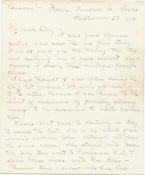“My Dear Lilly”
A letter from Annie Fellows Johnston to a close friend, Lilly (??We think Lillian Barbour of Evansville, IN), sent from Boerne Texas, in September 1908. This letter is packed with previously unpublished background information on Annie Fellows Johnston’s personal life at the time, as well as quite a bit of insight on The Giant Scissors and Mary Ware, the Little Colonel’s Chum.
“Penacres” — Boerne, Kendall Co. Texas
September 23, 1908
I had your steamer postal, and now the one from Vevey. I am so glad you are having this trip and realizing one of your dearest daydreams of seeing the beautiful foreign places.1
I have thought of you often during the long hot summer, but never got around to a letter, because I was taxed to the limit of my endurance by foolishly allowing myself to be persuaded to write another book.
Mamie2 went back to Kentucky in May to escape the heat. She is as much of an invalid now as John — although not from the same cause.3 She stayed with Hallie8 till July, then went to Providence, R. I. to spend three weeks with Mrs. Bliss. — (General Bliss’s widow, who has her winter home in Boerne and is one of the most charming old ladies I ever knew).4 Then she went back to Pewee.
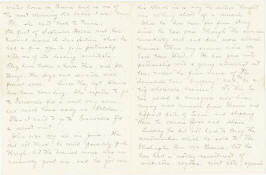 The first of September Hallie and her husband moved to San Antonio, where he had a fine offer to go into partnership with one of its leading architects. They have taken a house there and Mr. Burge, the dogs and servants will follow soon. Since they left Mamie has been boarding. She expects to go to Evansville for a week very soon, and reach home early in October. Then I want to go to Evansville for a short visit.
The first of September Hallie and her husband moved to San Antonio, where he had a fine offer to go into partnership with one of its leading architects. They have taken a house there and Mr. Burge, the dogs and servants will follow soon. Since they left Mamie has been boarding. She expects to go to Evansville for a week very soon, and reach home early in October. Then I want to go to Evansville for a short visit.
John was very ill in June. We did not think he could possibly pull through, but the trained nurse was an unusually good one, and he got over his attack in a way the doctors thought was nothing short of a miracle.
While he has been far from strong since, he has gone through the summer remarkably well, and done more actual business than any summer since we have been West. He has gone into partnership with a young naturalist out here, under the firm name of the “Armadillo Curio Company,” and they do a big wholesale business. To this he has added a menagerie side-line, buying wild animals from Mexico and different parts of Texas, and shipping them to various zoos and shows.
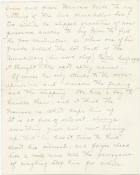 Luckily he did not have to bring the mountain-lion which he sold to the Washington Zoo, via Boerne, but he has had a motley assortment of wild-cats, coyotes, civet cats, squirrels
Luckily he did not have to bring the mountain-lion which he sold to the Washington Zoo, via Boerne, but he has had a motley assortment of wild-cats, coyotes, civet cats, squirrels
foxes and queer Mexican birds, to say nothing of the live armadillos here. For awhile he shipped quantities of non-poisonous snakes to the big zoos to feed the boa-constrictors, so when one old his friends called the lot back of the Armadillary (his work-shop) Hell’s half-acre I thought the spot aptly named.5
Of course he only attends to the correspondence and oversees the feeding and shipping. He has a boy to handle them, and I think the business is what keeps him up. It is so full of interest, always something queer and new turning up, that he hasn’t time to think about his ailments, and forges ahead like a well man till the paroxysms of coughing stop him for awhile.
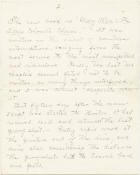 The new book is “Mary Ware: The Little Colonel’s Chum.” It was written in the midst of countless interruptions, ranging from the most serious to the most unexpected and ridiculous. Really the last two chapters seemed fated not to be written, so many things interfered, and I was almost desperate over it.
The new book is “Mary Ware: The Little Colonel’s Chum.” It was written in the midst of countless interruptions, ranging from the most serious to the most unexpected and ridiculous. Really the last two chapters seemed fated not to be written, so many things interfered, and I was almost desperate over it.
But fifteen days after the manuscript was started to Boston, I had received, read and returned the last proof-sheet. — pretty rapid work at the printers’ end of the line, and mine also, considering the distance the proof-sheets had to travel back and forth.
I have a feeling that the book cannot be as good as its predecessors, squeezed out as it was “in the midst of alarms” and such frequent “scenes of confusion,” but I think the allegory of “The Jester’s Sword” is the very best 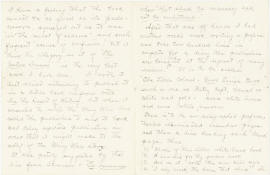 work I have done. I wrote it last winter intending to publish it in a little book, uniform with “In the Desert of Waiting,” but when I consented to write the Mary Ware book, asked the publishers to send it back and delay separate publication in order that I might make it the motif of the Mary Ware story. It was partially suggested by that line from Stevenson — “Torenounce when that shall be necessary and not be embittered.”
work I have done. I wrote it last winter intending to publish it in a little book, uniform with “In the Desert of Waiting,” but when I consented to write the Mary Ware book, asked the publishers to send it back and delay separate publication in order that I might make it the motif of the Mary Ware story. It was partially suggested by that line from Stevenson — “Torenounce when that shall be necessary and not be embittered.”
After that was off hands I had another week’s work writing a preface and over two hundred lines in couplets for a diary the publishers are bringing out at the request of many readers. It is to be called “The Little Colonel – Good Times Book,” such a one as Betty kept, bound in white and gold – some white linen and some white morocco.
There is to be an autographed preface, twelve illuminated calendar pages, and then a line heading each blank page thus
(1) Make of this little white-bound book
(2) A sun-dial for thy garden nook
(3) And on it write the sun-dial sign
(4) “I only mark the hours that shine” etc.
I think the cover design is to be a rosary of pearls, such as Lloyd strung.
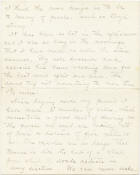 It has been so hot in the afternoons and I was so busy in the mornings that I have made no calls the entire summer. My sole diversion and exercize has been walking down for the last mail after sun-down, the round trip not amounting to more than 1¾ miles.
It has been so hot in the afternoons and I was so busy in the mornings that I have made no calls the entire summer. My sole diversion and exercize has been walking down for the last mail after sun-down, the round trip not amounting to more than 1¾ miles.
Since laying aside my pencil I have made a number of calls , which necessitates a good deal of driving as the people we visit are mostly out of town a distance of five miles or so. The ranches are so large that Boerne is like the hub of a wheel from which the roads radiate in every direction. We can never make
more than one visit in an afternoon, since every one lives at the end of a different road from any of his neighbors.
Now I am catching up with my letters – so many, many, from inquisitive readers. Such a dear one yesterday 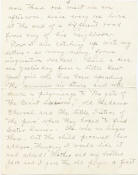 from a little New York girl who has been spending the summer in Tours, and who made a pilgrimage to the “Gate of the Giant Scissors,” old Madame Chevral6 and the Little Sisters of the Poor where they hoped to find Sister Denisa. She was no longer there, but the child procured her address, thinking I would like it, and added: “Mother and my brother Jack and I gave the old people a feast
from a little New York girl who has been spending the summer in Tours, and who made a pilgrimage to the “Gate of the Giant Scissors,” old Madame Chevral6 and the Little Sisters of the Poor where they hoped to find Sister Denisa. She was no longer there, but the child procured her address, thinking I would like it, and added: “Mother and my brother Jack and I gave the old people a feast
of tobacco, snuff, candy, sugar and cakes, in your honor. They were delighted and we left the old men smoking and sneezing and the old women munching their candies. They all sent you a special “God Bless you”.7
This certainly is a personal letter, but I know you are interested in all that pertains to us.
Give my love to Viva. I am so glad you have such a delightful travelling companion as I am sure she would 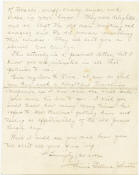 make. John sends his love to you. I wish you could know how many times he refers to Mr. Barbour, quoting him and talking so affectionately of the old Junior League days.
make. John sends his love to you. I wish you could know how many times he refers to Mr. Barbour, quoting him and talking so affectionately of the old Junior League days.
Wish I could see you and hear you tell about all your fine trip.
Lovingly, as ever
Annie Fellows Johnston
(This letter is in the Samuel Culbertson Mansion collection)
Notes:
- Lillian may be visiting the places mentioned in “The Giant Scissors”?
- Mamie = Mary Johnston, Annie’s step-daughter. This “invalid” lived another 58 years. She is as much as anyone, the Joyce Ware of the stories.
- John, Annie’s step-son, had tuberculosis. He died of it in 1910. He was a primary model for the character Jack Ware.
- Speculation here that Mrs. Bliss may have been the real life model for Mrs. Barnaby in “Mary Ware in Texas” Boerne, TX, of course, was the Bauer of the story.
- The menagerie Annie is describing here found its place in “Mary Ware, The Little Colonel’s Chum” also published in 1908, Chapter 14. Also, no doubt that she had her son John in mind for the ill-fated Jack Ware character, and she had undoubtedly written “The Jester’s Sword” for John as well before she decided to incorporate it into the Mary Ware story (see further down the letter).
- The real name of the model for Mme Gréville of the Giant Scissors story.
- The Little Sisters of the Poor is an order of nuns (originating in France: Les Petites Soeurs des Pauvres) that has long had a presence in Evansville, IN, Annie Fellows Johnston’s ‘home town’. This connection may have had something to do with Annie incorporating the French facility in Tours into her Giant Scissors story. Sister Denisa de la Provence herself had come from Cincinnati. What we can say is that there actually was a Sister Denisa, and that was her real name, as this letter and notes from “Land of the Little Colonel” (1929) verify. AFJ also uses the incident of the girl visiting the Little Sisters almost verbatim 20 years later in “Land of the Little Colonel”
- Hallie that this was her cousin Hallie Burge Jacob. Hallie had been married five years by this time and we do not know where she was living — quite possibly with her father, Albert Burge, since when the Jacobs moved to San Antonio, we know they brought her father with them.
